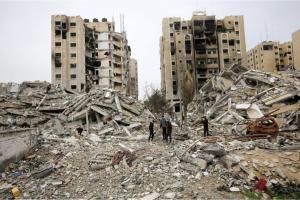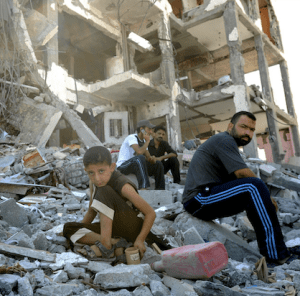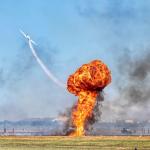CNN reported on Sunday’s horrors in Rafah for a few excruciating hours, then veered quickly to a new, more comforting headline: “Israel’s Prime Minister Benjamin Netanyahu has said Sunday’s deadly Israeli airstrike on a Rafah camp had gone tragically wrong.”
Other mainstream media performed a similar sleight-of-hand (if the news cycle ever slows down, I’ll show you a few examples).
Alternative news outlets, instead of soothing the consciences of pro-Israel evangelicals, are still covering the actual incident, and the world’s outrage.
Here is a factual rundown of the weekend’s events:
At least 45 Palestinians, including at least 23 women, children and elderly people, were killed in an Israeli attack on a camp for Palestinians displaced from the southern city of Rafah, the Gaza health ministry said on Monday.
The targeted area, which is crowded with thousands of displaced persons, was previously declared as a safe zone by Israel.
The Palestine Red Crescent Society (PRCS) confirmed that the people who were inside the tents, mostly children and women, were burnt alive.
Video from the site showed scenes of horror: charred bodies being pulled from rubble, a man holding the headless body of a child, fire raging from tents in the background.
“We saw charred bodies and dismembered limbs … We also saw cases of amputations, wounded children, women and the elderly,” Mohammad al-Mughayyir, a Gaza civil defense agency official told AFP.

One of the Gazan victims of the airstrike was a pregnant woman.
The only hospital in Rafah has only eight beds and does not have an ICU unit, [so] the hospitals are not capable of treating all of these severe injuries.
There are a couple of field hospitals in Rafah, but unfortunately, there is no fuel for ambulances to go back and forth and transfer all of the people injured.
In the midst of medics frantically trying to help the injured and shroud the dead, there were reports of an Israeli drone strike on the hospital’s entrance, where two staff members were killed.
The attack on Rafah was carried out using seven 2,000-pound (one-ton) bombs (read more about these bombs below).
The Palestinian Gov’t Media Office regarded the attacks as a “clear message” from Israel and the United States government to the International Court of Justice (ICJ) and the global community that “the massacres against displaced persons and children will continue, and that breaking international law will not stop.”
The International Court of Justice (ICJ) has ruled Friday that Israel must halt its offensive in Gaza’s Rafah, following a plea from South Africa.
Israel explains why it attacked Rafah:
The Israeli army has said eight rockets were launched from the Rafah area in southern Gaza at central Israel. Israel’s air defense system intercepted several of them, the army said.
The rocket strikes caused minor injuries to two Israelis (approximately 52 Israelis have been killed by Palestinian rockets since 2002).
This was reportedly the first rocket attack on the Tel Aviv region in six months.
According to police, the roof of a home in Herzliya was damaged by shrapnel following a rocket barrage over central Israel. A woman who was inside the home was lightly injured while trying to move to safety.
MORE ON THE BOMBS USED ON RAFAH:
Why the US Paused the Delivery of 2,000-Pound Bombs to Israel Ahead of a Possible Rafah Attack

With more than 1 million refugees sheltering in Rafah, U.S. officials are concerned the bombs could inflict massive casualties. Human rights groups have long said that Israel’s use of powerful bombs has caused the indiscriminate killings of civilians.
Defense Secretary Lloyd Austin told a Senate panel Wednesday that smaller, more precise weapons are needed for a densely populated area like Rafah.
The bombs are “dumb” or unguided bombs but can be turned into more precise weapons with the addition of Joint Direct Attack Munition kits, or JDAM kits which add a tail fin and navigation.
That added kit enables troops to guide the munition to a target, rather than simply dropping it from a fighter jet onto the ground. The kits make the weapons more precise, but in a densely populated urban environment, a JDAM kit is not going to make much of a difference — a precise hit will still have the reach to kill unintended bystanders.
The Israeli military has said little about what kinds of bombs and artillery it is using in Gaza. But from blast fragments found on-site and analyses of strike footage, experts are confident that the vast majority of bombs dropped on the besieged enclave are U.S.-made. They say the 2,000-pound bombs have killed hundreds in densely populated areas.
The 2,000- and 500-pound bombs are some of the main munitions used by Israel in its seven-month war campaign, Bryant said.
“They have been burning right through them,” said Bryant. He said the munitions are made by major American weapons manufacturers like Raytheon, Northrop, Lockheed Martin, General Dynamics and General Atomics.
At the hearing, Austin questioned whether the 2,000-pound bomb was the right tool for the Rafah operation.
“It’s about having the right kinds of weapons for the task at hand. And a small diameter bomb, which is a precision weapon, that’s very useful in a dense, built-up environment,” said Austin, “but maybe not so much a 2,000-pound bomb that could create a lot of collateral damage.” He said the U.S. wants to see Israel do “more precise” operations.
These are the very bombs that Israel used over the weekend.
UPDATE: As it turns out, the bombs used were a bit smaller (but not small enough). Read more here.
As I recently wrote, I have for the time being washed my hands of Christians who refuse to engage with the issue of Palestine, and for now (at least until the end of this horrific war) I will be writing about the significance of what is going on “over there” from a global and historic perspective.
I’m here for anyone who cares to have an intelligent conversation about reality, instead of living in a silo of confirmation bias.
I invite you to subscribe to my newsletter. I write about the Palestine-Israel issue regularly, and other issues relevant to progressives or those considering becoming progressive. If you would like to comment on this post, please pop over to my Facebook page. All of my posts are there and open to constructive comment. I welcome your thoughts.
If you are interested, here are some of my earlier posts on the Palestine issue:
Further reading on the Palestine-Israel issue:
- Israel, the ICC, and the disintegration of our species
- The truth about Gazans as human shields –you’ll be surprised
- THIS RIGHT HERE is happening RIGHT NOW. This is Israel.
- Unlock the global and historic significance of this moment
- What to say when you’ve run out of words
- A 3-minute challenge to see whether you are alive
- Did you know the US is complicit in genocide RIGHT NOW?
- 5 tips for finding the best news reporting on Palestine
- You need to meet this little girl named Hind
- Does Israel really have “the most moral army in the world”?
- Western “civilization” exposed for its colossal ruthlessness
- To Biden, Palestinian genocide is already complete
- The lies we believe about Gazan Christians are killing them
- Can followers of the Prince of Peace support a group that uses violence?
- Why support for Palestinian resistance is the right response for Christians
- A Palestinian Pastor’s powerful message to us: “it’s time to stop praying”
- Christians: Why do we skimp on compassion when it comes to Palestinians?
- Don’t compromise truth on Israel and Palestine
- What People Of Faith Need To Know About Gaza And Israel Right Now
Posts about my Gazan family (in chronological order):
- Follow this refugee family’s quest for survival in Gaza
- The hardest decision our family in Gaza has ever made
- The unexpected one-word message coming out of Gaza today
- The new normal: eating during a famine in Gaza
- The truth about Gaza: “I swear, we don’t mind death”
- The reality of survival in Gaza, on Spiritual Brewpub
- 3 funerals and a wedding in Gaza
- “We’re surrounded. Israelis are everywhere. We are dying.”
- “We were surrounded by tanks. It’s a miracle we got out.”
- “If I Should Die Before I Wake”
FEATURED IMAGE: Ricardo Gomez Angel via Unsplash














